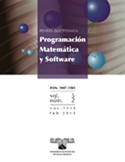Efficiency of the variable fidelity design optimization method with variable complexity models
DOI:
https://doi.org/10.30973/progmat/2015.7.1/7Keywords:
Scaling methods, Different degree of nonlinearity, Different number of design variables, Variable fidelityAbstract
The goal of this investigation is to provide a deeper understanding about a variable fidelity optimization algorithm and some scaling methods through three test problems. The first two problems are analytic, and the third one is a structural optimization problem. The test problems have been specifically constructed to look for insights regarding the use in the algorithm of models (high fidelity and low fidelity models) with different degree of nonlinearity and different number of design variables. Performance of the variable fidelity framework for first order and second order scaling methods (multiplicative and additive), is compared to a standard sequential quadratic programming optimization performed on the high fidelity model. The main contributions of this investigation are the insights gained with the specifically constructed test problems, which can be extended to other problems, about the use of a trust region variable fidelity framework, and the choice of the most suitable scaling methods depending on the case study at hand. In addition, results show how a reduction in the design cycle time can be obtained, by reducing the number of high fidelity function calls while achieving convergence.
References
Alexandrov, N. M., Dennis, J. E., Lewis, R. M., and Torczon, V. A Trust-Region Framework for Managing the Use of Approximation Models in Optimization. Structural Optimization. 1998, 15(1), 16-23. https://doi.org/10.1007/BF01197433
Rodriguez, J. F., Renaud, J. E., and Watson, L. T. Convergence of Trust Region Augmented Lagrangian Methods Using Variable Fidelity Approximation Data. Structural Optimization. 1998, 15(3-4), 141-156. https://doi.org/10.1007/BF01203525
Rodriguez, J. F., Renaud, J. E., and Watson, L. T. Trust Region Augmented Lagrangian Methods for Sequential Response Surface Approximation and Optimization. ASME Journal of Mechanical Design. 1998, 120(1), 58-66. https://doi.org/10.1115/DETC97/DAC-3773
Wujek, B. A. and Renaud, J. E. A New Adaptive Move-Limit Management Strategy for Approximate Optimization, Part 1. AIAA Journal. 1998, 36(10), 1911-1921. https://doi.org/10.2514/2.285
Wujek, B. A. and Renaud, J. E. A New Adaptive Move-Limit Management Strategy for Approximate Optimization, Part 2. AIAA Journal. 1998, 36(10), 1922-1937. https://doi.org/10.2514/2.287
Perez, V. M., Renaud, J. E., and Watson, L. T. An Interior-Point Sequential Approximate Optimization Methodology. Structural Optimization. 2004, 27(5), 360-370. https://doi.org/10.1007/s00158-004-0395-y
Bakr, M. H., Bandler, J. W., Madsen, K., Rayas-Sánchez, J. E., and Søndergaard, J. Review of the Space Mapping Approach to Engineering Optimization and Modeling. Optimization and Engineering. 2000, 1(3), 241-276. https://doi.org/10.1023/A:1010000106286
Qian, Z., Seepersad, C. C., Joseph, V. R., Allen, J. K., and Wu, C. F. J. Building Surrogate Models Based on Detailed and Approximate Simulations. ASME Journal of Mechanical Design. 2006, 128(4), 668-677. https://doi.org/10.1115/1.2179459
Osio, I. G. and Amon, C. H. An Engineering Design Methodology with Multistage Bayesian Surrogates and Optimal Sampling. Research in Engineering Design. 2005, 8(4), 189-206. https://doi.org/10.1007/BF01597226
Alexandrov, N. M. and Lewis, R. M. An Overview of First-Order Model Management for Engineering Optimization. Optimization and Engineering. 2001, 2, 413-430. https://doi.org/10.1023/A:1016042505922
Thokala, P. and Martins J. R. R. A. Variable-Complexity Optimization Applied to Airfoil Design. Engineering Optimization. 2007, 39(3), 271-286. https://doi.org/10.1080/03052150601107976
Eldred,M.S.,Giunta,A.A., and Collis,S.S.Second-Order Corrections for Surrogate-Based Optimization with Model Hierarchies. In: Proceedings of the 10th AIAA/ISSMO Multidisciplinary Analysis and Optimization Conference. Albany, New York, 2004. https://doi.org/10.2514/6.2004-4457
Gano, S. E., Renaud, J. E., and Sanders, B. Variable Fidelity Optimization Using a Kriging Based Scaling Function. In: Proceedings of the10th AIAA/ ISSMO Multidisciplinary Analysis and Optimization Conference. Albany, New York, 2004. https://doi.org/10.2514/6.2004-4460
Giunta, A. A. and Eldred, M. S. Implementation of a Trust Region Model Management Strategy in the Dakota Optimization Toolkit. In: Proceedings of 8th AIAA/NASA/ISSMO Symposium on Multidisciplinary Analysis and Optimization. Long Beach, CA, 2000. https://doi.org/10.2514/6.2000-4935
Alexandrov, N. M. and Lewis, R. M. An Overview of First-Order Model Management for Engineering Optimization. Optimization and Engineering. 2001, 2, 413-430. https://doi.org/10.1023/A:1016042505922
Haftka, R. T. Combining Global and Local Approximations. AIAA Journal. 1991, 29(9), 1523-1525. https://doi.org/10.2514/3.10768
Chang, K. J., Haftka, R. T., Giles, G. L., and Kao, P.-J. Sensitivity-Based Scaling For Approximating Structural Response. Journal of Aircraft. 1993, 30(2), 283-288. https://doi.org/10.2514/3.48278
Eldred, M. S., Giunta, A. A., and Collis, S. S. Second-Order Corrections for Surrogate-Based Optimization with Model Hierarchies. In: Proceedings of the 10th AIAA/ISSMO Multidisciplinary Analysis and Optimization Conference. Albany, New York, 2004. https://doi.org/10.2514/6.2004-4457
Gano, S. E., Perez, V. M., and Renaud, J. E. Multi-Objective Variable-Fidelity Optimization of a Morphing Unmanned Aerial Vehicle. In: Proceedings of the 45th AIAA/ASME/ASCE/AHS/ ASC Structures, Structural Dynamics & Materials Conference. Palm Springs, CA, 2004. https://doi.org/10.2514/6.2004-1763
Lewis, R. M. and Nash, S. G. A Multigrid Approach to the Optimization of Systems Governed by Differential Equations. In: Proceedings of the 8th AIAA/USAF/NASA/ISSMO Symposium on Multidisciplinary Analysis and Optimization. Long Beach, CA, 2000. https://doi.org/10.2514/6.2000-4890
Barnes, G. K. Master’s thesis. The University of Texas. Austin, Texas, 1967.
Wujek, B. A., Renaud, J. E., Batill, S. M. A Concurrent Engineering Approach for Multidisciplinary Design in a Distributed Computing Environment. In: N. Alexandrov, M. Y. Hussaini, eds., Multidisciplinary Design Optimization: State-of-the-Art. 1997, 80, 189–208.
Wujek, B. A., Renaud, J. E., Batill, S. M., Brockman, J. B. Concurrent Subspace Optimization Using Design Variable Sharing in a Distributed Design Environment. Concurrent Engineering. 1996, 4(4), 361-377. https://doi.org/10.1177/1063293X9600400405
Downloads
Published
How to Cite
Issue
Section
License
Copyright (c) 2015 Programación Matemática y Software

This work is licensed under a Creative Commons Attribution 4.0 International License.
Usted es libre de:
 |
Compartir — compartir y redistribuir el material publicado en cualquier medio o formato. |
 |
Adaptar — combinar, transformar y construir sobre el material para cualquier propósito, incluso comercialmente. |
Bajo las siguientes condiciones:
 |
Atribución — Debe otorgar el crédito correspondiente, proporcionar un enlace a la licencia e indicar si se realizaron cambios. Puede hacerlo de cualquier manera razonable, pero de ninguna manera que sugiera que el licenciador lo respalda a usted o a su uso. |
| Sin restricciones adicionales: no puede aplicar términos legales o medidas tecnológicas que restrinjan legalmente a otros a hacer cualquier cosa que permita la licencia. |










